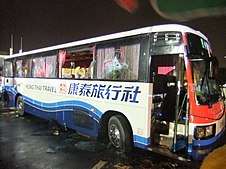| Manila hostage crisis | |
|---|---|
 The bus on which the hostages were held captive and later murdered | |
| Location | Quirino Grandstand, Rizal Park, Manila, Philippines |
| Coordinates | 14°34′48″N 120°58′28″E / 14.58000°N 120.97444°E |
| Date | August 23, 2010 10:00 a.m. – 9:00 p.m. (UTC+08:00) |
| Target | Hong Kong tourists on board a bus |
Attack type | Hostage crisis, siege, mass murder |
| Weapons | |
| Deaths | 9 (including the perpetrator)[1][2] |
| Injured | 9 (7 hostages and 2 bystanders) |
| Perpetrator | Rolando Mendoza[2] |
| Motive | To get his job as a Senior PNP officer back and his benefits along with it |
The Manila hostage crisis, officially known as the Rizal Park hostage-taking incident (Tagalog: Pagbibihag ng bus sa Maynila),[3] took place when a disgruntled former Philippine National Police officer named Rolando Mendoza hijacked a tourist bus in Rizal Park, Manila, Philippines, on August 23, 2010. The bus carried 25 people: 20 tourists, a tour guide from Hong Kong, and four local Filipinos. Mendoza claimed that he had been unfairly dismissed from his job, and demanded a fair hearing to defend himself.[4][5]
Negotiations (which were broadcast live on television and the internet) broke down dramatically about ten hours into the stand-off, when the police arrested Mendoza's brother and thus incited Mendoza to open fire.[6] The bus driver managed to escape, and declared "Everyone is dead" before he was moved away by policemen.[7] Following a 90-minute gun battle, Mendoza and eight of the hostages were killed and several others injured.[8]
The Philippine and Hong Kong governments conducted separate investigations into the incident. Both inquiries concluded that the Philippine officials' poor handling of the situation caused the eight hostages' deaths.[9][10] The assault mounted by the Manila Police District (MPD), and the resulting shoot-out, have been widely criticized by pundits as "bungled" and "incompetent",[11] and the Hong Kong Government has issued a "black" travel alert for the Philippines as a result of the incident.[12]
On April 12, 2018, Philippine president Rodrigo Duterte publicly apologized for the incident on behalf of his country.[13]
- ^ "Manila hostage incident victim name list". Hong Kong's Information Services Department Press Release. August 24, 2010. Archived from the original on June 19, 2012. Retrieved August 24, 2010. – For the names in Chinese, see the versions in Traditional Chinese Archived December 4, 2011, at the Wayback Machine and Simplified Chinese Archived March 16, 2016, at the Wayback Machine
- ^ a b Conde, Carlos (August 23, 2010). "Gunman and 8 Hostages Dead in the Philippines". The New York Times. Archived from the original on June 10, 2022. Retrieved August 24, 2010.
- ^ Cite error: The named reference
IIRCwas invoked but never defined (see the help page). - ^ Cite error: The named reference
robleswas invoked but never defined (see the help page). - ^ Gregorio, Ann Rozainne R. (August 24, 2010).Timeline: Manila hostage crisis Archived September 23, 2015, at the Wayback Machine. BusinessWorld.
- ^ Cite error: The named reference
driverwas invoked but never defined (see the help page). - ^ "Driver escapes, says 'hostages all dead'". ABS-CBN News (in Tagalog). August 23, 2010. Archived from the original on September 3, 2010. Retrieved September 6, 2010.
- ^ Abuyuan, Gina (August 23, 2010). "9 killed in Manila hostage drama". Khaleej Times. Archived from the original on August 28, 2010. Retrieved April 23, 2011.
- ^ Cite error: The named reference
ReportDeliverywas invoked but never defined (see the help page). - ^ "Hong Kong inquest criticises Philippines on bus hijack". BBC. March 23, 2011. Archived from the original on May 11, 2011. Retrieved April 19, 2011.
- ^ MacKinnon, Ian; Foster, Peter (August 24, 2010). "Hostage rescue team 'bungled Philippines coach rescue'". The Daily Telegraph. Archived from the original on March 11, 2011. Retrieved April 23, 2011.
- ^ Cite error: The named reference
bbc310was invoked but never defined (see the help page). - ^ "After 8 years of silence: Duterte says sorry to China, HK over 2010 Luneta hostage crisis". Politiko. April 12, 2018.